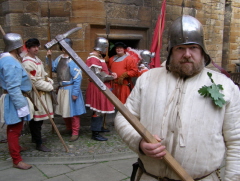16th Century Scottish Armies

A review of late medieval history allows us to reconstruct a battle at its highest level. It provides names, places and numbers but the tactical events are often left vague or exaggerated. It is as if the pieces have been set up on the chess board but without an understanding as to how the pieces move and attack then it is impossible to reconstruct the course of the game in detail.
This section of the site reveals how the Scottish army of the 16th Century went about its business. It describes the arms and equipment of the infantry, cavalry and the relative newcomer to the field; the artillery. It then considers how these units operated as individual units and when combined on the battlefield. In doing so it provides the framework on which to reconstruct the battle.
The Battle of Linlithgow Bridge sits neatly between two other major and well chronicled military actions at Flodden in 1513 and Pinkie in 1547, as well as a contemporary to great battles in Europe such as Pavia (1525). It could be assumed that we can interpolate between the military tactics used at these actions to draw a conclusion as to the type of warfare being fought in 1526. It could be argued therefore that we have a fairly good understanding of the nature of 16th Century warfare in Scotland.
However care must be taken in this methodology as these well publicised battles, unlike the battle at the brig, are major engagements fought on a national stage between major warring nations . The Battle of Linlithgow Bridge was neither as large or as pre-planned and fought between fellow Scots. We must therefore interpolate with due consideration to the prevailing strategic circumstance.
As you read the following pages please take time to consider what equipment you would have been able to afford to take with you on such a venture and what it must have been like to be in the ranks for a person of your status. You may consider such warfare as inhumane and brutal but remember that the nature of combat described below was considered by many in 16th Century Scotland, as the 'cutting edge' of military technology. There was no better way to wage war on your enemy at the time. They reflected on the power of the latest artillery as we today look upon with awe at the potential of nuclear weapons.

